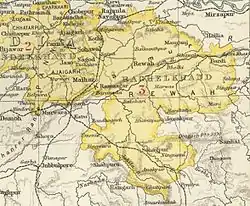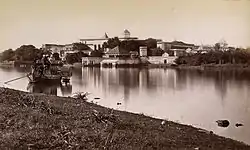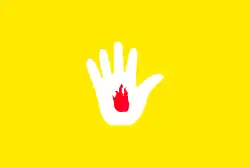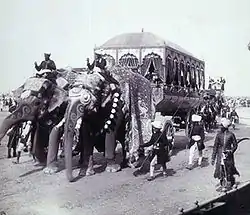Rewa (princely state)
Rewa State, also known as Rewah, was a princely state of India, surrounding its eponymous capital, the town of Rewa.[2]
| Rewa State Rewah State | |||||||
|---|---|---|---|---|---|---|---|
| Princely State of British India | |||||||
| c. 1790–1947 | |||||||
 Flag
 Coat of arms
| |||||||
 Rewah State in the Imperial Gazetteer of India | |||||||
| Area | |||||||
• 1901 | 33,670 km2 (13,000 sq mi) | ||||||
| Population | |||||||
• 1901 | 1327385 | ||||||
| History | |||||||
• Established | c. 1790 | ||||||
| 1947 | |||||||
| |||||||
| Today part of | India | ||||||
| Columbia-Lippincott Gazetteer. (New York: Columbia University Press, 1952) p. 369 | |||||||



With an area of about 34,000 km2 (13,000 sq mi), Rewa was the largest princely state in the Bagelkhand Agency and the second largest in Central India Agency. Rewa was also the third wealthiest principality in Central India, with an average revenue of Rupees 2.9 million in 1901.[3] The British political agent for Bagelkhand resided at Satna, on the East Indian railway. The Bagelkhand Agency was dissolved in 1933, following which Rewa was placed under the authority of the Indore Residency.
History
According to legend, the kingdom of Rewa was founded around 1140 CE. On 5 October 1812, it became a British protectorate. Between 1 April 1875 and 15 October 1895, Rewa remained under the direct colonial administration of British India.[4]
The ruler of Rewa ruled from Bandhavgarh during the founding reign of Raja Vyaghra Dev, who was a direct descendant of Gujarati warrior king Vir Dhawal. In the mid-1550s, Raja Ramachandra Singh Baghela maintained a musically talented court, including the legendary Tansen. In 1617, Maharaja Vikramaditya Singh moved his capital to Rewa. Maharaja Martand Singh was the last ruler of Rewa who acceded to the Union of India after the country became India.
Emperor Akbar was given refuge at Rewa at age 10, when his father Humayun fled India following a defeat in war. Prince Ramchandra Singh and Akbar grew up together as royal heirs. Maharaja Ramchandra Singh and Akbar stayed friends. Two of the Navratnas of Akbar, Tansen and Birbal (originally named Mahesh Das) were sent from Rewa by Maharaja Ramchandra Singh once Akbar became the Emperor of India.
Rewa was the first princely state in India to declare Hindi as a national language, in the times of Maharaja Gulab Singh. He is also credited for declaring the first responsible government in modern India, providing citizens of Rewa state a right to question their monarch's decisions.
The state came under British paramountcy in 1812 and remained a princely state within the British Raj until India's independence in 1947.
During the long minority of Raja Venkat Raman Singh (b.1876, r.1880–1918), the administration of the state was reformed. In 1901, the town boasted a high school, a "model jail" and two hospitals: the Victoria hospital and the Zenana hospital. However, it was still adjudged among the most backward areas of the country by V.P. Menon, after he visited the state in 1947.
Post-independence period
Upon India's independence in 1947, the maharaja of Rewa acceded unto the Dominion of India. Rewa later merged with the Union of India and became part of Vindhya Pradesh, which was formed by the merger of the former princely states of the Bagelkhand and Bundelkhand agencies. Rewa served as the capital of the new state.
In 1956, Vindhya Pradesh was merged with other nearby political entities to form the Indian constitutive state of Madhya Pradesh. The Maharaja's palace was converted into a museum.
In February 2007, the most-extensive book on the history of Rewa, Baghelkhand, or the Tigers’ Lair by Dr D.E.U Baker, was published by Oxford University Press.
Bagheli is local language of Rewa.
Rulers
The predecessor state Bandhogarh was founded c. 1140. The chiefs of Rewa were Baghels descended from the Solanki clan, which ruled over Gujarat from the 10th to 13th century. Vyaghra Deo, a brother of a ruler of Gujarat, is said to have made his way into northern India around the middle of the 13th century and gained the fort of Marpha, 29 km (18 mi) north-east of Kalinjar. His son Karandeo, married a Kalchuri (Haihaya) princess of Mandla, and received in dowry the fort of Bandhogarh which, until its destruction in 1597 by Akbar, was the Baghel capital. In 1298, Ulugh Khan, acting under orders of Mughal Padshah (emperor) Alauddin, drove the last Baghel ruler of Gujarat from his country and this is believed to have caused a considerable migration of Baghels to Bandhogarh. Until the 15th century, the Baghels of Bandhogarh were engaged in extending their possessions and escaped the attention of the Delhi Sultans, in 1498–1499, Sikandar Lodi failed in his attempt to take the fort of Bandhogarh.
List of rulers
The following is a list of known rulers of Rewa (or its predecessor state, Bandhogarh), in chronological order by their reign. They took the title of Raja or, from 1857, Majaraja or Maharaja.
- Raja Shaktivan Deo, r.1495–1500, Raja of Bandhogarh
- Raja Veer Singh Deo, r.1500–1540
- Raja Virbhan Singh, r.1540–1555
- Raja Ramchandra Singh, r.1555–1592
- Raja Duryodhan Singh (Birbhadra Singh), r.1593–1618 (deposed); His accession gave rise to disturbances. Akbar intervened, captured and dismantled the Bandhogarh fort in 1597 after a siege of eight months.
- Raja Vikramaditya, r.1618–1630. He founded the town of Rewa in 1618 (which perhaps means that he undertook the construction of palaces and other buildings there because the place had already assumed importance in 1554 when it was held by Jalal Khan, son of emperor Shershah Suri).
- Raja Amar Singh II, r.1630–1643
- Raja Anoop Singh, r.1643–1660
- Raja Bhao Singh, r.1660–1690. He married twice but died childless.
- Raja Anirudh Singh, r.1690–1700, a grandson of Raja Anoop Singh, he was adopted by and succeeded his childless uncle, Raja Bhao Singh.
- Raja Avadhut Singh, r.1700–1755. The state was sacked by Hirde Shah of Panna, c.1731, causing the Raja to flee to Pratapgarh in Oudh (Awadh).
- Raja Ajit Singh, r.1755–1809.
- Raja Jai Singh, b.1765, r.1809–1835. In 1812, a body of Pindaris raided Mirzapur from Rewa territory, for which Jai Singh was called upon to accede to a treaty acknowledging the protection of the British Government, and agreed to refer all disputes with neighbouring chiefs to their arbitration and to allow British troops in his territories.
- Raja Vishwanath Singh, b.1789, r.1835–1854.
- Raja Raghuraj Singh Ju Deo Bahadur, b.1831, r.1854–1857 as Raja then as Majaraja 1857–1880. He helped the British quell the uprisings in the neighbouring Mandla and Jabalpur districts in the mutiny of 1857. For this service the Sohagpur (Shahdol) and Amarkantak parganas were restored to his rule (having been seized by the Marathas in the beginning of the century), and he was made the first Majaraja of Rewa, ruling until his death on 5 February 1880.
- Maharaja Venkatraman Ramanuj Prasad Singh Ju Deo, b.1876, r.1880–1918.
- Maharaja Gulab Singh Ju Deo, b.1903, r.1918–1946 (deposed).
- Maharaja Sajjan Singh of Ratlam (Regent), b.1880, r.1918–1919, 1922–1923.
- Philip Bannerman Warburton (Interim), b.1878, r.1919.
- Dewan Bahadur Brijmohan Nath Zutshi (Regent, President of Regency Council), b.1877, r.1920–1922.
- Elliot James Dowell Colvin (Interim), b.1885, r.1922.
- Maharaja Martand Singh Ju Deo, b.1923, r.1946–1995.
References
External links
 Media related to Rewa State at Wikimedia Commons
Media related to Rewa State at Wikimedia Commons- . Encyclopædia Britannica. 23 (11th ed.). 1911. pp. 224–225.